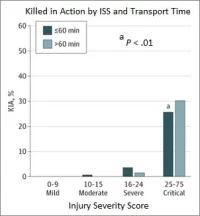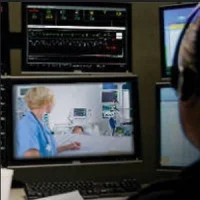When patients present with organ failure to French teaching hospitals, the receiving hospitals have very varied staffing and organisation, according to a survey by the French Society of Anesthesiology & Intensive Care - Sociéte française d’anesthésie et de réanimation (SFAR). The results of the survey have been published in the Society’s journal, Anaesthesia Critical Care & Pain Medicine.
Lead author, Dr. Hervé Quintard, University Hospital of Nice, told ICU Management that the management and role of intensivists and anaesthesiologists in this situation has never been assessed before in France. This survey was intended as the first step to describe effective organisation for patients with a life-threatening condition.
The criteria for receiving patients with a life-threatening condition were highly variable, as were staffing and organisation.
In 18% of hospitals, such patients were treated in a specialised room in the ICU; in 40% of hospitals they were treated in a specialised room in the emergency department (Service d’admission des urgences vitales [SAUV]) Intensivists were involved in 50% of hospitals, emergency physicians in 26% and staffing was mixed in 24% of hospitals.
 Dr. Quintard (pictured left) told ICU Management that the most surprising finding was the heterogeneity of organisation of in-hospital primary care, which could have an impact on patient prognosis. He noted: “These observations underlined the fact that the same patient could have different care according to his geographic situation. For example, a thoracic trauma could be treated directly by intensivists in ICU whereas in another hospital it could be treated by physicians, not always trained to manage trauma, in an emergency room not always dedicated for unstable patients.”
Dr. Quintard (pictured left) told ICU Management that the most surprising finding was the heterogeneity of organisation of in-hospital primary care, which could have an impact on patient prognosis. He noted: “These observations underlined the fact that the same patient could have different care according to his geographic situation. For example, a thoracic trauma could be treated directly by intensivists in ICU whereas in another hospital it could be treated by physicians, not always trained to manage trauma, in an emergency room not always dedicated for unstable patients.”
The specialist physicians could be reached in 20 (84%) of hospitals, but a formal network was efficient in only 11 (45%) of the hospitals. Dr. Quintard observed that most teaching hospitals had specialist physicians in their organisation, but a network to develop direct contact with specialists is essential to improve prognosis.
Next Steps
The authors recommend that consensus be sought to homogenise and improve practice. Dr. Quintard observed that to their knowledge no recommendations or guidelines for hospital organisation dedicated to extra hospital critically ill patients have been published before. There has been major work on organisation of prehospital care in the last few years, and ICU/hospital directors need to work on these networks to mitigate disparities.
The authors conclude that the logical and most efficient approach is to favour direct hospitalisation of patients with several organ failures in an ICU rather than in a salle d’accueil des urgences vitales (SAUV). Dr. Quintard told ICU Management that “The right patient in the right place “ is essential for improving prognosis of patients. A better interaction between prehospital care and intra hospital orientation is essential for improving procedure. They plan to investigate non-teaching hospitals in due course.
In an accompanying editorial, Dr. Pierre Bouzat, Dr. Pierre-Géraud Claret and Dr. Jean-François Payen write: “Improving the morbidity and the mortality in these pathologies is undoubtedly linked to networking that provides the perfect path from initial symptoms to definitive treatment. They add: “The heterogeneity of leadership in French ERs only illustrates heterogeneous local expertise. Everyone should follow the leader in the ER and the leader is the one who knows!”
Claire Pillar, ICU Management
Source: Anaesthesia, Critical Care & Pain Medicine; Interview
Image source: freeimages.com
Lead author, Dr. Hervé Quintard, University Hospital of Nice, told ICU Management that the management and role of intensivists and anaesthesiologists in this situation has never been assessed before in France. This survey was intended as the first step to describe effective organisation for patients with a life-threatening condition.
Results
The criteria for receiving patients with a life-threatening condition were highly variable, as were staffing and organisation.
In 18% of hospitals, such patients were treated in a specialised room in the ICU; in 40% of hospitals they were treated in a specialised room in the emergency department (Service d’admission des urgences vitales [SAUV]) Intensivists were involved in 50% of hospitals, emergency physicians in 26% and staffing was mixed in 24% of hospitals.
 Dr. Quintard (pictured left) told ICU Management that the most surprising finding was the heterogeneity of organisation of in-hospital primary care, which could have an impact on patient prognosis. He noted: “These observations underlined the fact that the same patient could have different care according to his geographic situation. For example, a thoracic trauma could be treated directly by intensivists in ICU whereas in another hospital it could be treated by physicians, not always trained to manage trauma, in an emergency room not always dedicated for unstable patients.”
Dr. Quintard (pictured left) told ICU Management that the most surprising finding was the heterogeneity of organisation of in-hospital primary care, which could have an impact on patient prognosis. He noted: “These observations underlined the fact that the same patient could have different care according to his geographic situation. For example, a thoracic trauma could be treated directly by intensivists in ICU whereas in another hospital it could be treated by physicians, not always trained to manage trauma, in an emergency room not always dedicated for unstable patients.” The specialist physicians could be reached in 20 (84%) of hospitals, but a formal network was efficient in only 11 (45%) of the hospitals. Dr. Quintard observed that most teaching hospitals had specialist physicians in their organisation, but a network to develop direct contact with specialists is essential to improve prognosis.
Next Steps
The authors recommend that consensus be sought to homogenise and improve practice. Dr. Quintard observed that to their knowledge no recommendations or guidelines for hospital organisation dedicated to extra hospital critically ill patients have been published before. There has been major work on organisation of prehospital care in the last few years, and ICU/hospital directors need to work on these networks to mitigate disparities.
The authors conclude that the logical and most efficient approach is to favour direct hospitalisation of patients with several organ failures in an ICU rather than in a salle d’accueil des urgences vitales (SAUV). Dr. Quintard told ICU Management that “The right patient in the right place “ is essential for improving prognosis of patients. A better interaction between prehospital care and intra hospital orientation is essential for improving procedure. They plan to investigate non-teaching hospitals in due course.
In an accompanying editorial, Dr. Pierre Bouzat, Dr. Pierre-Géraud Claret and Dr. Jean-François Payen write: “Improving the morbidity and the mortality in these pathologies is undoubtedly linked to networking that provides the perfect path from initial symptoms to definitive treatment. They add: “The heterogeneity of leadership in French ERs only illustrates heterogeneous local expertise. Everyone should follow the leader in the ER and the leader is the one who knows!”
Claire Pillar, ICU Management
Source: Anaesthesia, Critical Care & Pain Medicine; Interview
Image source: freeimages.com
References:
Quintard H, Severac M, Martin C, Ichai C; emergency intensive care group of the French Society of Anesthesiology, Intensive Care (Sociéte française d’anesthésie et de réanimation “Sfar”) In-hospital organization of primary care of patients presenting a life-threatening emergency: A French national survey in 32 university hospitals (2015). Anaesth Crit Care Pain Med, 34(4):225-30. doi: 10.1016/j.accpm.2015.04.001. [Epub ahead of print]
Bouzat P, Claret P-G, Payen J-F (2015) Management of life-threatening emergencies in France: follow the leader! Anaesth Crit Care Pain Med, 34(4):189-90. doi: 10.1016/j.accpm.2015.07.001
Bouzat P, Claret P-G, Payen J-F (2015) Management of life-threatening emergencies in France: follow the leader! Anaesth Crit Care Pain Med, 34(4):189-90. doi: 10.1016/j.accpm.2015.07.001
Latest Articles
Critical care, organ failure, France, teaching hospitals
Results of a survey of French teaching hospitals on care of critically ill patients presenting to the emergency department with organ failure. Interview with Dr. Hervé Quintard.










